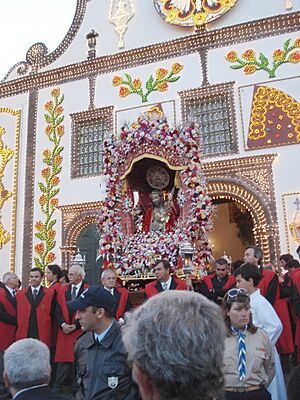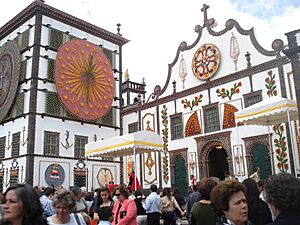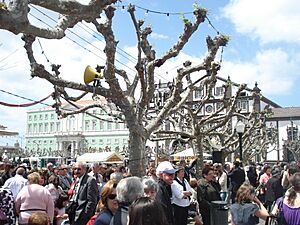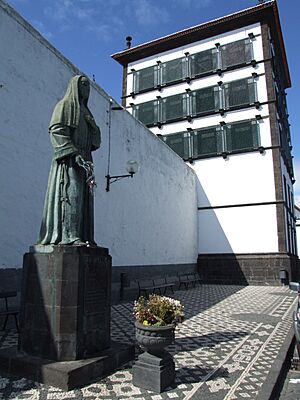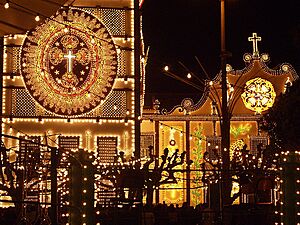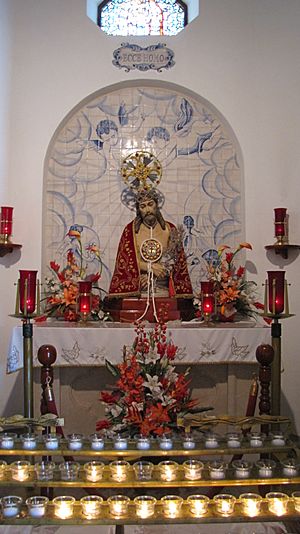Cult of the Lord Holy Christ of the Miracles facts for kids
Quick facts for kids Senhor Santo Cristo dos MilagresFesta do Senhor Santo Cristo dos Milagres
|
|
|---|---|
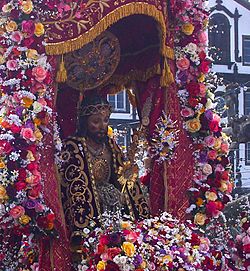
The image of The Lord Holy Christ of the Miracles at the beginning of the procession in His honour in Ponta Delgada, Azores.
|
|
| Status | Active |
| Genre | Religious Feast |
| Date(s) | Fifth Sunday of Easter |
| Begins | Fifth Sunday of Easter |
| Ends | Ascension Thursday |
| Frequency | Annually |
| Venue | Campo de São Francisco |
| Location(s) | Ponta Delgada, Azores |
| Country | Portugal |
| Years active | 1700 |
| Inaugurated | 13 April 1700 |
| Founder | Venerable Mother Teresa da Anunciada |
| Most recent | 24 April 2016 |
| Previous event | 3 May 2015 |
| Next event | 14 May 2017 |
| Website | |
The Cult of the Lord Holy Christ of the Miracles (in Portuguese: Culto do Senhor Santo Cristo dos Milagres) is a very important religious event. People often call it Senhor Santo Cristo or Santo Cristo dos Milagres. It is a special way of honoring an image of Jesus Christ.
This wooden image shows Jesus after he was whipped. He wears a crown of thorns and his body looks bruised. The artist made the image show a strong contrast. It shows the violence on his body but also a calm look on his face.
Usually, this statue is kept in the Sanctuary of the Lord Holy Christ. This sanctuary is inside the Convent of Our Lady of Hope in Ponta Delgada. Ponta Delgada is on São Miguel Island in the Azores. Every year, the statue is carried in a big parade through the city streets.
The celebrations for the Lord Holy Christ of the Miracles happen on the fifth Sunday after Easter. A large procession walks through the capital city. The events finish on Ascension Thursday. These celebrations are some of the oldest and most important religious traditions in Portugal. Thousands of people come to Ponta Delgada each year for these events. Many are from the Azores, or are descendants of Azoreans living elsewhere.
Contents
History of the Celebration

The story of this special devotion began with the Convent of Caloura. This convent was founded by two sisters. A Pope, either Pope Paul III or Pope Clement VII, gave the image of Christ to the nuns. It was placed in a special spot for several years.
The Convent of Caloura was on a cliff by the sea. This made it easy for pirates to attack. Because of this, many nuns moved to safer convents. One of these was the Convent of Our Lady of Hope in Ponta Delgada. In 1541, a nun named Mother Inês de Santa Iria moved the image of Christ there.
Mother Teresa da Anunciada's Role
The devotion to this image grew a lot in the 1600s and 1700s. This was thanks to Venerable Mother Teresa da Anunciada. She joined the Convent of Esperança in the 1600s. Mother Teresa was very religious and inspired many people. She deeply loved the image of Christ. She called it "her Lord" and "her Nobleman."
Mother Teresa worked hard to make the image famous. She wanted people to show their devotion to Jesus Christ. Even though the head nun tried to stop her, Mother Teresa built a chapel for the image. She also decorated it like a king's statue. She collected donations from many faithful people for this. In 1700, the King of Portugal, Pedro II of Portugal, even gave money to keep a lamp burning in front of the altar.
The First Procession
In 1700, the island of São Miguel had many earthquakes. They lasted for several days. Mother Teresa convinced the city leaders to carry the image of Santo Cristo in a procession. They believed this would stop the tremors. Mother Teresa helped organize many of the traditions for the annual procession. This included moving the statue from the church to circle the Campo de São Francisco square.
On April 13, 1700, the first procession took place. Many religious groups, nobles, and faithful people gathered. They hoped for a miracle. When the image appeared, people cried and showed great emotion. Many poor people walked barefoot. Important people carried the statue. The procession stopped at several convents and churches along its route.
The Miracle of 1713
Another important event happened on December 17, 1713. Earthquakes were shaking the islands again. The leaders of Ponta Delgada decided to have another procession. Everyone walked barefoot. As the holy image was leaving the Church of the Jesuit College, it fell. Right at that moment, all the earthquakes stopped!
People saw this as a miracle from God. Some fell to their knees and prayed. Others cried and asked for forgiveness. The image itself was not badly damaged, only its right arm. It was cleaned at the Convent of Saint Andrew. The procession continued, and people kept crying tears of joy and relief.
Rituals and Traditions
During the celebrations, the Convent of Our Lady of Hope and the Campo de São Francisco square are beautifully lit up. Locals and visitors gather in the square. They admire the decorated church and tower.
On the Saturday before the main procession, many people visit the image. They make promises to God. Sometimes, they walk on their knees across the Campo de São Francisco. In the afternoon, the nuns give the image to the Brotherhood. This group is in charge of the celebrations. The image is then moved to the altar of the Church of Our Lady of Hope. Sometimes, it is moved to the nearby Church of Saint Joseph for more space.
Between Saturday and Sunday morning, many faithful people stay awake. They watch over the image and pray. Some even travel from other parts of the island to be there.
On Sunday afternoon, the grand procession takes place. The parade walks through the main streets of the city. It passes by many churches and convents.
The Procession Route
The first procession was started by Mother Teresa da Anunciada. She wanted to ask for God's help during the earthquakes. The image was moved from the Convent and carried through the city. When it appeared, the crowd was very emotional, and the earthquakes stopped.
During the celebrations, the crowd and the image circle the Campo de São Francisco and the Convent. This shows deep faith and respect. Many people also "pay promises" to God. This means they fulfill a promise they made in exchange for a prayer being answered.
Most of the year, the image is kept safe in a special chapel. This chapel is inside the Church of Nossa Senhora da Esperança. It is behind glass and iron bars. The tradition of the annual procession has continued ever since the first one. Only very bad weather has stopped it.
The Sanctuary and its Treasures
Before Mother Teresa da Anunciada, the image was in a small, less important altar. Mother Teresa worked hard to build a new, more respectful chapel for it. She got help from the people and even the King.
The original chapel is no longer there. The current chapel was finished in 1771. It has beautiful tile work called azulejos. These tiles show scenes from the life of Christ. The tiles inside the chapel were made in Lisbon between 1786 and 1787.
The Treasure of the Lord Holy Christ
The "treasure" of the Lord Holy Christ includes many valuable jewels and decorations. These are used to adorn the image. It has many capes made of gold and silver thread, with precious stones. This collection is one of the most important from the 1700s. These treasures are gifts from faithful people, nobles, and even the Portuguese royal family. They are often given as thanks for prayers answered.
Mother Teresa da Anunciada started the idea of making the simple image look grand. Many pieces were added after her death in 1738. For example, a sceptre, a crown of thorns, and a special chest piece were donated. These items are decorated with pearls, topaz, and emeralds.
The image wears different red capes. These are gifts from local communities or from Azoreans living in other countries. Many people believe that these blessed capes can help heal the sick. The first platform used to carry the image was designed by Mother Teresa herself. It was decorated with flowers. This platform is still used today with few changes.
The Cult Around the World

The devotion to the Lord Holy Christ of the Miracles quickly spread from Ponta Delgada to other islands in the Azores. This happened because it was hard for people from other islands to travel to Ponta Delgada. Today, the Lord Holy Christ is honored throughout the islands. After Ponta Delgada, the biggest celebrations are in Vila do Porto on Santa Maria Island and on Graciosa island.
Many Azoreans have moved to the United States and Canada. Because of this, the devotion to Senhor Santo Cristo dos Milagres has spread there too. Celebrations and processions are held in many cities in North America. Examples include Brampton, Cambridge, London, Kingston, and Leamington in Ontario, Canada. Also, cities like Fall River and Cambridge in Massachusetts, and others in Rhode Island in the United States. In Fall River, a church was even built just for the Holy Christ.
In Hamilton, on the Bermuda islands, there is also a special procession to honor the Holy Christ of Miracles.


